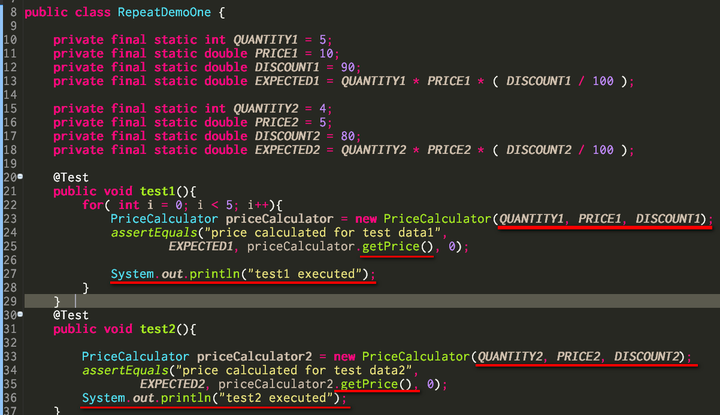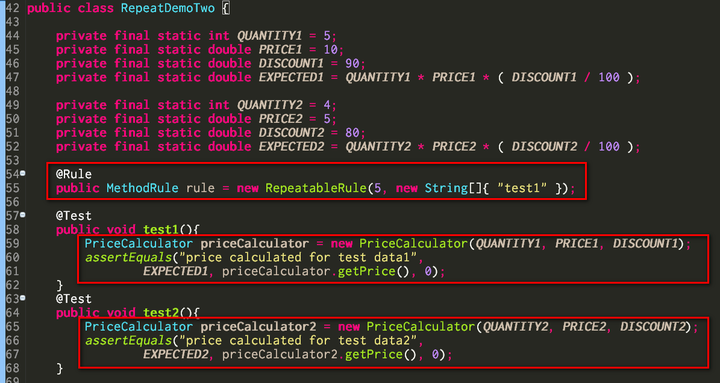Suppose I have four test cases in my project, the total methods to be tested:

Based on the blog Run only given sets of your unit test via @Category, it is possible to organize test methods within THE SAME CLASS to different categories via @Category, that is, the granularity to control which test methods should be executed is method level.
There is another annotation @SuiteClasses which can allows us to categorize test classes into different test suites, and once we specify a given test suite to be executed, all test classes within that suite would be executed one by one.
For example, I create a suite TestSuite1and2 and only put first and second test case into it, so when this test suite is executed, only three test methods ( 1 from first test case and 2 from second test case ) are executed:

And the same logic for TestSuite2and3:

If you need to integrate test suite execution into Maven, add the following parts in pom.xml:
<plugin>
<groupId>org.apache.maven.plugins</groupId>
<artifactId>maven-surefire-plugin</artifactId>
<configuration>
<includes>
<include>${runSuite}</include>
</includes>
</configuration>
</plugin>Then use the following command line:

You will get exactly the same result as in Eclipse:

要获取更多Jerry的原创文章,请关注公众号"汪子熙":








相关推荐
4. **测试注解的扩展**:除了基本的`@Test`,JUnit还提供了其他注解,如`@Before`和`@After`,分别在每个测试方法之前和之后执行,常用于初始化和清理工作。`@BeforeClass`和`@AfterClass`则在整个测试类的生命周期...
1.junit 常用注解 @Before 初始化方法,每次测试方法调用前都执行一次。 @After 释放资源:每次测试方法调用后都执行一次 @Test 测试方法:在这里可以测试期望异常和超时时间 @ignore 忽略的测试方法 @BeforeClass ...
JUnit 类别 JUnit 4.9 引入了一个很好的注释来对您的测试进行分类。 而 TestNG 选择为使用字符串 JUnit 类别使用类。 这比字符串更灵活,这在使用多模块 maven 项目时可能会很痛苦(有关更多详细信息,请参阅 JUnit ...
@SuiteClasses 用于套件测试 @BeforeClass @Before @After @AfterClass这些注解标注的方法又称测试的Fixture。 JUnit为所有原语类型、对象和数组(原语或对象)提供重载断言方法。参数顺序为预期值后接实际值。或者...
介绍如何利用反射和注解去简单的模拟JUnit4单元测试的使用,之所以选择JUnit4是...需要注意的是这里并不是完全的模拟,只是简单实现了一下Runner类和JUnit注解相关的工作流程。所以本文的主要目是介绍反射和注解的使用
Java单元测试是软件开发过程中的重要环节,它用于验证代码的独立模块是否按预期工作。JUnit是Java领域最广泛使用的单元测试框架,它为开发者提供了一种简洁、高效的测试工具。JUnit 4.7是该框架的一个版本,包含了对...
### JUnit5 用户手册知识点详解 #### 一、概述 JUnit5是一款强大的单元测试框架,相较于之前的版本进行了大幅度的重构和改进。它由三个主要部分组成:JUnit Platform、JUnit Jupiter和JUnit Vintage。这三个部分...
总的来说,了解和掌握Spring的事务管理机制以及如何在JUnit测试中使用@Transactional注解,对于Java开发者来说是非常重要的技能。这不仅可以帮助你在开发过程中确保数据的一致性,也能在单元测试中有效地验证代码的...
在Java的单元测试框架JUnit 5中,`@ParameterizedTest` 和 `@EnumSource` 是两种非常实用的注解,它们可以有效地提高测试代码的复用性和覆盖率。`@ParameterizedTest` 允许我们将测试方法参数化,也就是说,同一个...
8. **测试套件(Test Suites)**:使用`@RunWith(Suite.class)`和`@Suite.SuiteClasses`注解定义测试套件。 9. **注解驱动**:JUnit 4不再强制测试类继承`TestCase`,而是通过注解来标识测试类和方法。 在从JUnit ...
junit-extension 背景 原生的Junit无法满足我们在自动化测试实践过程中的碰到一些需求,比如 ...以上三种注解和Junit build-in的注解@Test配合使用,示例如下 import org.junit.Test; import org.sdet.junit.extens
Java自定义注解是Java平台...以上就是关于Java自定义注解、标签库、监听器和JUnit简单测试的知识点概述。这些技术是构建可扩展、可维护的Java应用程序的关键组成部分,理解并熟练运用它们能够提升代码质量和开发效率。
在本文中,我们将深入探讨如何在JUnit中利用`@Rule`注解来测试文件和目录,从而提升测试的覆盖率和实用性。 `@Rule`是JUnit框架中的一个重要概念,它允许我们定义自定义的测试规则。这些规则会在测试方法执行前后被...
JUnit提供了`@RunWith`和`@SuiteClasses`注解来定义一个测试套件,一次性运行多个测试类: ```java package note.junit; import org.junit.runner.RunWith; import org.junit.runners.Suite; import org.junit....
jUnit 5引入了JUnit Jupiter模块,提供了新的API和注解,比如`@DisplayName`、`@Tag`、`@Nested`等,增强了测试的可读性和组织性。 通过本教程,你应该能掌握jUnit的基本用法,并能在实际项目中编写和执行单元测试...
概述 JUnit工具箱提供了一些有用的类,用于使用... 尽管它扩展了WildcardPatternSuite您不必强制使用通配符模式,但也可以使用JUnit已知的@SuiteClasses批注列出子类。 -甲更换为JUnit运行Enclosed ,其执行与注释
JUnit 5提供了元注解和组合注解的功能。元注解是用于标记其他注解的注解,组合注解是由多个注解组合而成的注解。这些功能可以帮助开发者更方便地编写单元测试。 9. 定义 在JUnit 5中,定义是指测试类和测试方法的...
JUnit4的核心变化之一就是引入了注解,这使得测试类和方法的声明更加简洁。例如,`@Test` 注解标记测试方法,`@Before` 和 `@After` 分别用于在每个测试方法前和后执行的设置和清理代码。还有 `@BeforeClass` 和 `@...
* @SuiteClasses:用于组合多个测试类 三、Junit 的最佳实践 Junit 的最佳实践包括: * 测试代码必须简单到能直接看清楚测试逻辑 * 不能为了适应测试而修改源代码 * 待测试对象及辅助对象在@Before 方法中初始化 ...